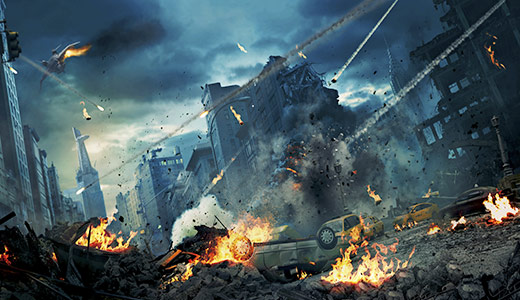If you’ve been to a big-budget blockbuster at the multiplex recently—and by recently, I mean, oh, say, the last decade or two—you might have noticed some significant similarities between films when the heavy cinematic artillery swings into action. Namely, whether we’re dealing with science fiction, super heroes or fantasy, the scope of destruction is simply epic. Vast. Cataclysmic. Apocalyptic. There’s never nothing less at stake, it seems, than the very future of humanity. Cities are sure to be destroyed. (The only thing that might exempt this Friday’s Mad Max: Fury Road from the same metropolis-crushing treatment is that, in Mad Max’s world, all the cities have already been crushed.)
In the first Avengers film back in 2012, for instance, Earth’s Mightiest Heroes square off against a horde of aliens known as the Chitauri. Oh, and that Norse god of mischief, Loki. Result? New York City takes it on the chin. Hard. And if the Avengers fail? Well, it’s lights out for the carbon-based bipeds we like to call humanity.
Though the villain is different in the latest Avengers’ film (a megalomaniacal, homicidal robot instead of a megalomaniacal, homicidal alien), the scope of destruction is similar. Sure, the Avengers talk about wanting to limit civilian casualties. And, well, perhaps they do. A little. Meanwhile, three cities (one in Africa, one in Europe, one in Asia) get the full New York-style treatment. (I’m sure residents of the Big Apple were breathing a sigh of relief.)
Even in a more serious movie like, say, like Christopher Nolan’s Interstellar, everything hangs in the balance should Matthew McConaughey and Anne Hathaway fail in their quest to locate a new home for humanity.
As visually spectacular as these ginormously expensive special effects sagas are, sometimes it all feels a little much. It can leave an apocalypse-weary filmgoer wondering, Does everything have to get blown up?
The answer, according to screenwriter and producer and producer Damon Lindelof, is yes.
Lindelof rose to prominence alongside J.J. Abrams as one of the main writers for ABC’s cult hit Lost. Among his other high-profile writing credits are Star Trek Into Darkness, Prometheus, World War Z and Cowboys & Aliens. Another Lindelof story, Tomorrowland, debuts next week.
In an interview given to vulture.com two years ago, Lindelof talked about his two massive movies released that summer, Into Darkness and World War Z. And though two years is generally a mighty long time in pop culture, his comments about this apocalyptic, cinematic arms race are as relevant now as they were in the summer of 2013.
“We live in a commercial world, where you’ve gotta come up with ‘trailer moments’ and make the thing feel big and impressive and satisfying, especially in that summer-movie-theater construct,” Lindelof said. “But ultimately I do feel—even as a purveyor of it—slightly turned off by this destruction porn that has emerged and become very bold-faced this past summer. And again, guilty as charged. It’s hard not to do it, especially because a movie, if properly executed, feels like it’s escalating.”
Lindelof further notes that just saving one person—or even a single city—just doesn’t raise the emotional stakes high enough for the average 21st-century viewer.
Once you spend more than $100 million on a movie, you have to save the world. And when you start there, and basically say, I have to construct a MacGuffin based on if they shut off this, or they close this portal, or they deactivate this bomb, or they come up with this cure, it will save the world—you are very limited in terms of how you execute that. And in many ways, you can become a slave to it and, again, I make no excuses, I’m just saying you kind of have to start there. In the old days, it was just as satisfying that all Superman has to do was basically save Lois from this earthquake in California. The stakes in that movie are that the San Andreas Fault line opens up and half of California is going to fall in the ocean. That felt big enough, but there is a sense of bigger, better, faster, seen it before, done that.
He also added, “It’s almost impossible to, for example, not have a final set piece where the fate of the free world is at stake. You basically work your way backward and say, ‘Well, the Avengers aren’t going to save Guam, they’ve got to save the world.’ Did Star Trek Into Darkness need to have a gigantic starship crashing into San Francisco? I’ll never know. But it sure felt like it did.”
Elsewhere in the lengthy article, Vulture writer Scott Brown noted:
Hollywood’s gigantism, Lindelof points out, is practically algorithmic—and the effect tendrils all the way down to the storytelling level. When ever-larger sums are spent to make and market ever-fewer, ever-bigger movies, and those movies are aimed at Imax screens, then world—shattering comic-book I.P. and gigantic special effects are expected, with larger-than-life characters wielding those effects. No one necessarily asks for it; it just kind of happens. It’s what Lindelof calls Story Gravity, and dealing with it—whether that means resisting it or simply surfing it skillfully—is the great challenge of writing this new breed of tentpole blockbuster. The question used to be: How do we top ourselves? The new one seems to be: How do we stop ourselves?
With Avengers: Age of Ultron well on its way to another billion-dollar-plus haul in just a couple of weeks in global theaters, this ever-escalating, bigger-is-always-better trend in blockbusters shows no signs of abating any time soon.






Recent Comments